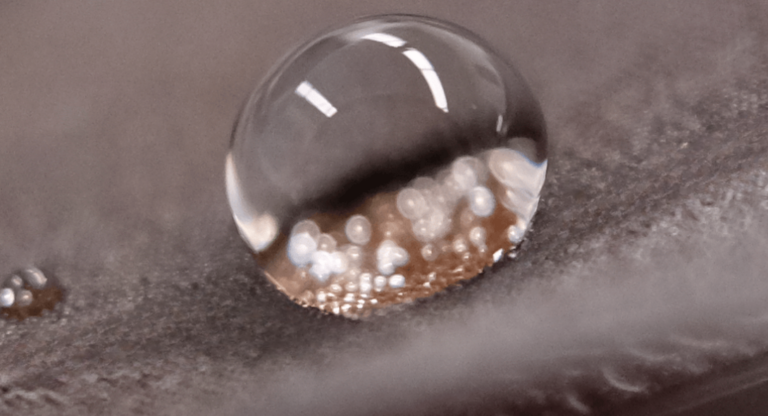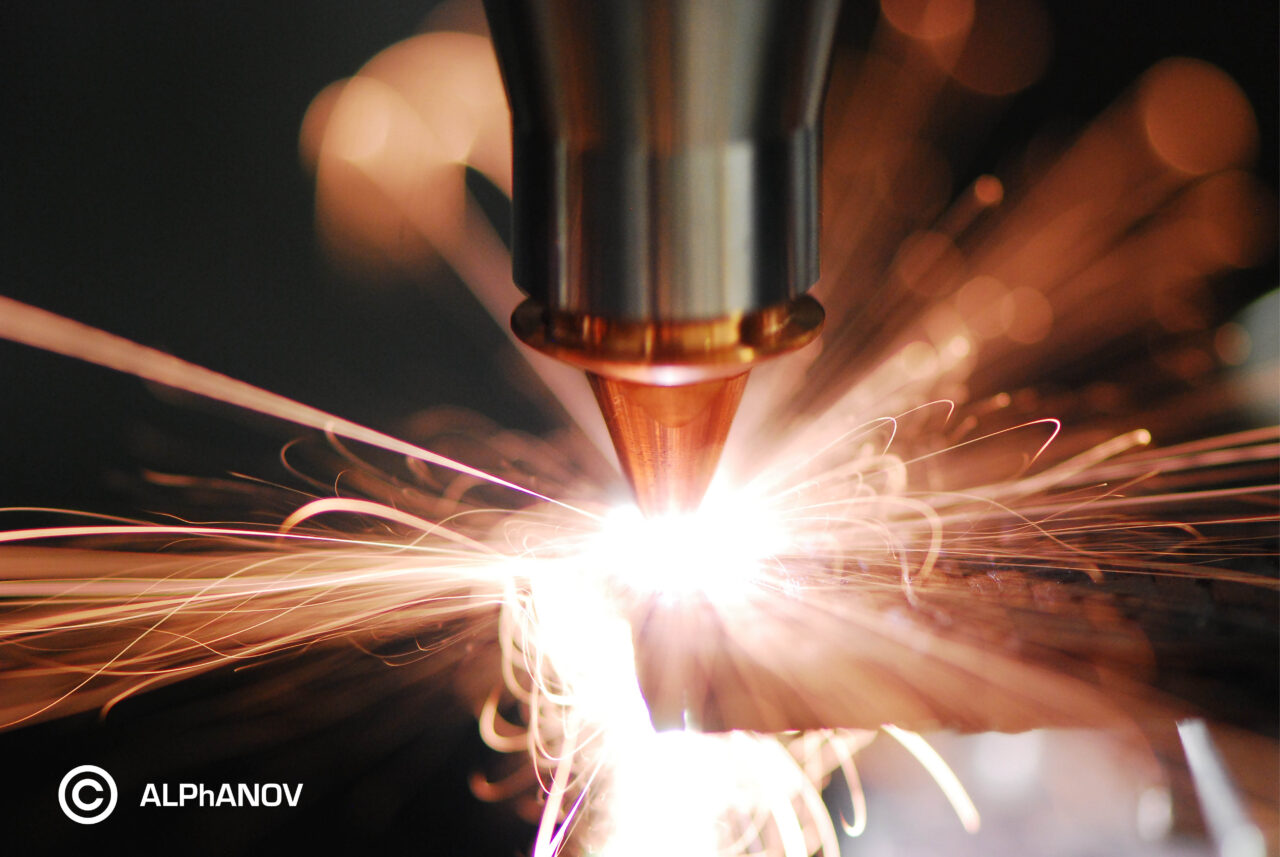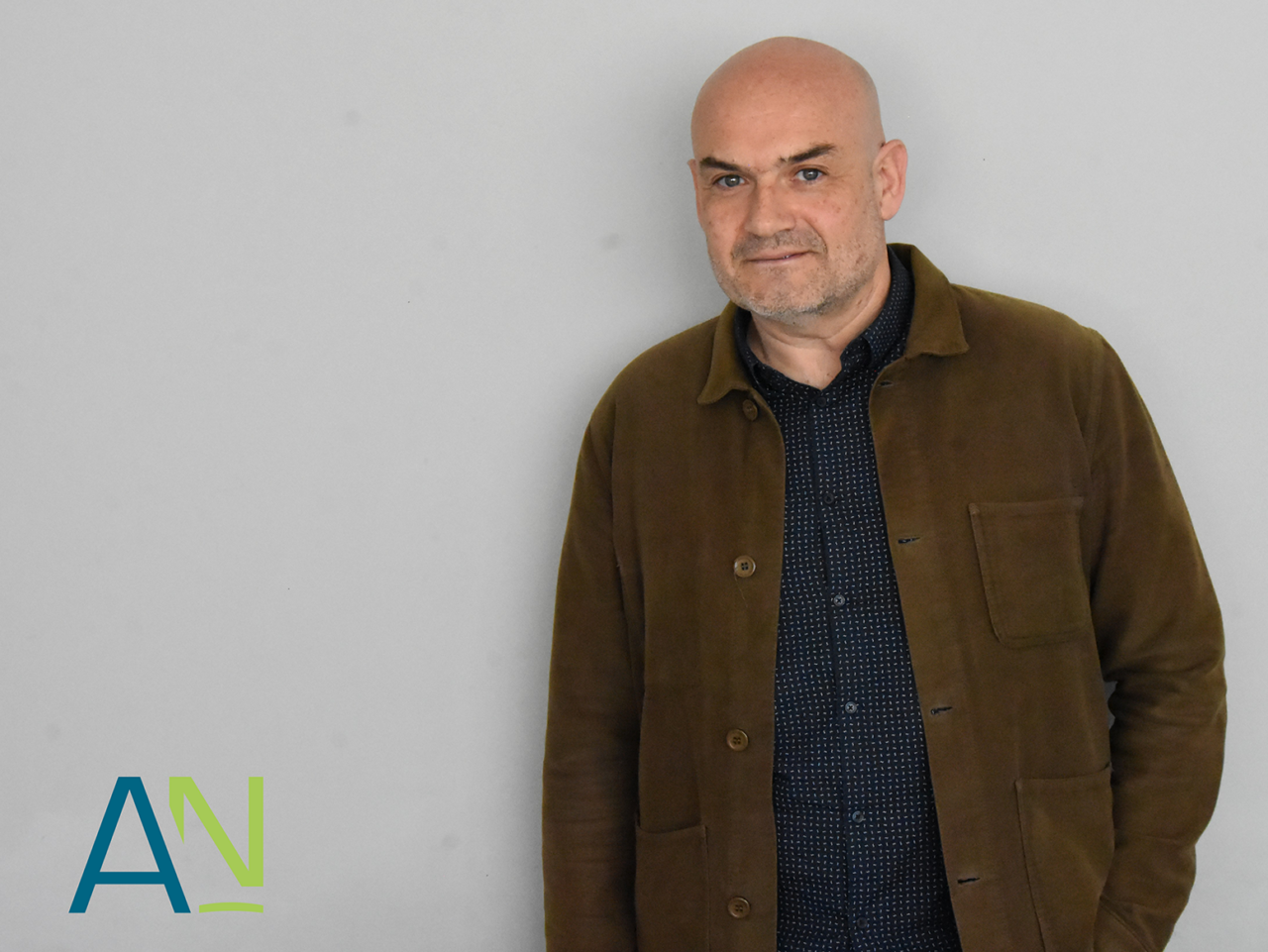Laser-based surface functionalisation
Functional properties of BioFibreLoop’s textiles will be generated by using a bionic approach. Special surface structures found on fish and other living organisms will be transferred onto technical coatings produced in our project.
Today, we’ll learn more about those structures and how this transfer onto the textile actually works.
Therefore, we interviewed two experts: Girolamo Mincuzzi from ALPhANOV, a expert in laser technology, and Thomas Stegmaier from DITF who has already been our expert for the last blog article about coating.

Water drop on functionalised surface. ©DITF
How exactly do surface structures cause functional properties? Which surface structures found in nature did you select to create water and oil repellence as well as antibacterial behaviour?
Thomas:
“Micro- and nanostructures present on surfaces generally increase the water repellency of hydrophobic surfaces. The contact angle of a drop of water to such surfaces becomes higher due to such structuring, compared to completely flat surfaces. Therefore, a drop of water rolls off very easily. Dirt particles or bacteria have only a low adhesion to such surfaces while the adhesion to water drops is higher. This means that such contaminations are picked up and rolled away by drops of water when those are rolling over these surfaces. Hence, hydrophobic surfaces cause also antibacterial activity to some degree. Such hydrophobic surfaces can often be observed in nature on the leaves of plants in our latitudes, this can especially be seen in the morning when the dew forms round drops on the leaves.
Furthermore, we also want to further enhance the antibacterial activity of the surfaces we design. In nature, we can find interesting structures on spider silk surfaces. The antibacterial properties of spider silk are based on several factors. First, spider silk contains components that possess antimicrobial properties. These can attack the cell walls of bacteria and inhibit their growth. In addition, the structure of spider silk, which is very strong and flexible, also influences its interaction with microbes. The physical properties of the silk can make it harder for bacteria to adhere to the surface, which also leads to reduced bacterial colonisation.
In addition to high water repellency and antibacterial behavior, we also strive for a certain level of oil repellency by applying special forms of microstructures. The living nature also shows us beautiful examples of this, such as certain surfaces on some fish species. However, such surfaces have not yet been scientifically researched and transferring them to industrial technology is very challenging.”
How does the transfer of our chosen special structures onto the coating of the textile work?
Thomas:
In our project we are working with lignin on a new type of coating on textiles. Lignin is a component of wood and is usually produced as a waste material during the extraction of cellulose for paper production. The properties of lignin as a coating on textiles are very suitable for many technical applications. Of course, the lignin still needs to be modified so that it meets the many demands of processing and the end products. We are currently working very intensively on this in the laboratories. You can read more about that in the previous blog article.
The goal is to give these coatings the microstructures on the surface that we have learned from living nature to repel water, oil and bacteria. Since we are working with thermoplastic lignin in the project, the surface can be structured using temperature and pressure. This is done using heated embossing rollers. These rollers have a negative structure on the metal surface that has been engraved with our chosen structure by laser. The lignin coating softens under the heat and the structure is pressed in with pressure by the embossing roller. The process is basically simple. However, the very special microstructures that we want to achieve require intensive development of all sub-components and process parameters in the embossing process.”
What are benefits of using the laser-based surface functionalisation, what are the reasons for using this method in BioFibreLoop?
Girolamo:
“A laser is a one-of-a-kind tool for manufacturing, capable of achieving both incredibly precise details at the micrometre scale and high-speed processing. Pulsed lasers, especially those with ultrashort pulses in the femtosecond range (1fs = 10⁻¹⁵ seconds!), have a unique ability to reshape surfaces on their own.
In BioFibreLoop, we’re therefore able to mimic textures we found in nature with our laser-made patterns and “put them on textile”. Alongside surface chemistry, they help to recreate the same functional properties found in nature for the clothing produced.
To follow up Thomas’ answer to the surface structures: As a general rule, different surface patterns can lead to different functional properties. In recent years, a wide range of laser-created patterns has been developed, each designed to give surfaces special properties. Using a laser, we can create patterns at the nanometre, micrometre, or even multi-scale level (where nanometre structures form on micrometre patterns), resulting in what’s known as hierarchical structures. As consequence, hierarchical texturing allows us to create textiles with several functional properties!
Additionally, unlike traditional industrial methods for creating patterns or surface textures, laser-based techniques don’t require any chemicals, making them a much safer and more environmentally friendly option.
To sum it up, the laser is a very efficient and safe tool to produce functionalised surfaces.”
You both have a given us a short overview how the functionalisation process works in BioFibreLoop. Let’s have a closer look at the single steps. As first step of developing the functionalisation process you had to determine the parameters of the structures e. g. exact size/density/form of the micro- and nanostructure elements. How did you do that exactly? What did you have to consider?
Thomas:
“As in any bionic development, the first step is to understand the mechanisms that we see in living nature. Using knowledge from chemistry and physics, the functionality is then well explained and, ideally, numerically simulated. Building on this process, the creative phase of technical implementation into a product then takes place.
In our case, we explained the microstructures and how they work based on our understanding and derived a model from them. Based on these models, the creative phase of technical implementation takes place, which is at the same time focused by the set framework conditions. In this case, these are the technical possibilities of lasering metal surfaces and the embossing process of a thermoplastic material.”
Once the parameters of microstructures have been set up, the negative of those patterns have to be engraved on the laser as a second step. How is this done? Are there any challenges or risks you have to consider?
Thomas:
“ The desired structures are burned into the engraving rollers using a suitable laser. Important factors here are the depth, the distance and the resolution of the structures. The resolution indicates, among other things, how sharp the edges of the structures are.”
Girolamo:
“The optimisation of laser machining processes is done varying a bunch of laser parameters (energy, scan speed, beam trajectories, pulse overlapping, etc.). Our starting point is the experience we have built over the past years by understanding how the laser-matter interaction varies when depending on these parameters. Tailoring the process to reach the goal is almost a handcrafted job, maybe tomorrow AI will make it straightforward. The challenge will be to keep the same results over a large surface made of a novel material, in a continuous process. To tackle this, we rely on a set of innovative optical systems like fast scanners with large field, precise laser robots as well as the development of a new specific set-up. For the latter, the expertise of our project partners will be absolutely essential.”
You already described the third and final step of functionalisation more detailed, the hot embossing, the transfer of the structures from the metal rollers onto the coated textile. Is there anything to consider for the development and optimisation of this process?
Thomas:
“Of course, embossing coated textiles also has special requirements. On the one hand, the process should be carried out very quickly for high productivity and low costs. On the other hand, the textile must also have reached the necessary temperature through heating. Imprinting the structures into the softened heated surface also takes time. There is also another very important property here: the viscosity of the heated thermoplastic coating. This must be well coordinated with the desired structures.”
BioFibreLoop aims for the creation of technical textiles with the highest possible durability. Please give an estimation: How stable will the structures on the coated textiles be?
Girolamo:
“In the proposal we made an estimation based on previously reported studies on textured textiles made of conventional polymer and we can expect a stability of the structures that will last for 40-50 washing cycles.”
Please give a vision. How will BioFibreLoop’s innovations regarding the laser-based biomimetic functionalisation affect the laser and/or textile industry of tomorrow?
Girolamo:
“We believe femtosecond laser technology has now reached a level where it can fully realise its potential as a unique and highly beneficial manufacturing tool. It’s moving beyond its traditional niche areas—such as precision micromechanics, eye surgery, and micro-electronics — and gaining an ever-ubiquitous diffusion into sectors with much larger societal impact. BioFibreLoop offers a strategic opportunity to push this progress even further.”

Laser engraving of a metal plate. ©ALPhANOV
About Girolamo Mincuzzi

Girolamo Mincuzzi. ©ALPhANOV
Who are you and what is your role in the project?
“I have 20 years of experience in applied physics and laser technology. I’m passionate about technological innovation, especially when it has the potential to genuinely improve people’s lives—though that’s not always the case. In BioFibreLoop I’m the project manager and principal investigator for ALPhANOV, where I work with other engineers and young scientists. I’d like to mention Kamil Aouti, Valentin Gartiser, and Wahib Mirgan Barkat.”
What has been/will be your personal highlight in the project?
“I’ve been involved in BioFibreLoop since the consortium first started, contributing ideas to the proposal and helping to find the right partners for each task. I’m new to textile technology, just as laser technology might be unfamiliar to some of our partners. I find the cross-fertilisation of these two fields particularly exciting, and it’s something I’m personally very interested in.”
Can you share any funny or unexpected moments or learnings that you experienced while your worked on this project?
“It’s quite funny to see people’s reactions when I say, “Well, to sum it up, I use a laser to create rose petal-like textures on biodegradable jackets—so people can work in safer conditions..“
What type of BioFibreLoop clothing (active wear, outdoor wear, work wear) are you personally most excited about?
“I probably have a slight preference for workwear. I’d be really happy if, by the end of BioFibreLoop, we’ve helped improve workplace safety with high-performance clothing while also proving that it can be done sustainably.”



